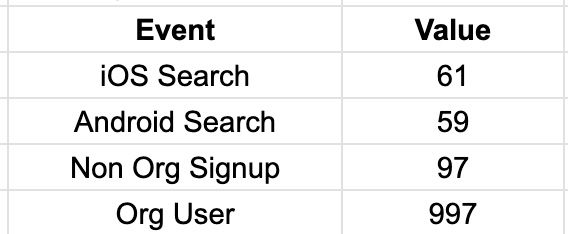I’ve long heard the idea of keeping same conversion number for identical set of conversions. While it may make things simple, some extra thinking in assigning different conversion values can help you – in some ways that are mentioned below and many others – depending on your use case.
Suppose on our landing page, https://aso.Xappsai.com/, We have following events:
- People who search for PlayStore App.
- People who search for iOS App.
- People who signup using free account (eg: gmail)
- People who signup using work email address.
I have following options:
- Map the conversion event – and say that all the events are quantitively the same.
- Give different conversion values for each event.
Now, I’ve noticed that often, the second point is not well thought, and generally, the ad managers keep values like 100, 200 or 1, 2 etc. It’s a very inefficient use of a great tool. This number should always reflect the value of that conversion for your business. Additionally, you can use a prime number for reverse engineering.
In this case, we setup the below conversion value for the events. (I could keep, 50,50, 100, 1000 and 4000 too, but I use prime numbers, so that I don’t have to toggle segment on Google Ads UI or create more rows in the ad report).
| Event | Value |
| iOS Search | 61 |
| Android Search | 59 |
| Non Org Signup | 97 |
| Org User (ROW) | 997 |
| Org User (T1) | 4001 |
Prime numbers can make your reports brief and insightful. One of the reasons why Google Ads report is extremely difficult – is because of various segments.I like to keep these prime numbers, so that we could quickly see what happens with the ad campaigns. (This approach loses it’s value if you have 50 conversion events daily – for your #1 KPI).
Why not use a lower prime number, such as 3 or 7?
Consider the following scenario:
Suppose, we set the conversion value to 3 (gmail and 5 org ) respectively. => So, if we get 10 gmail signups, we’d get a total value of 3*10 = 30 in a day. Now, I cannot say if it’s 10 gmail users or 5 org users.
How to use this for companies of all size.
- Companies that expect less than 100 conversions, can pick any prime number for conversion value that is higher than the total conversion count that they expect for a given day. (So if I expect 50 conversions a day, then I can pick prime numbers from 59 – leaving some buffer).
- Companies that expect less than 1000’s of conversions While you may need a spreadsheet to differentiate between two events with similar conversion value (or set your report to give you those columns), you can see clear patterns – both in terms of your ROAS (Return on Ad Spend) and conversion events. For instance, in case of a signup, you could have a value of 97, whereas, if the user verifies their phone, they could be 101. (So when I look at the master report, I’d be able to see a similar number – if I had set 100 for each conversion).

